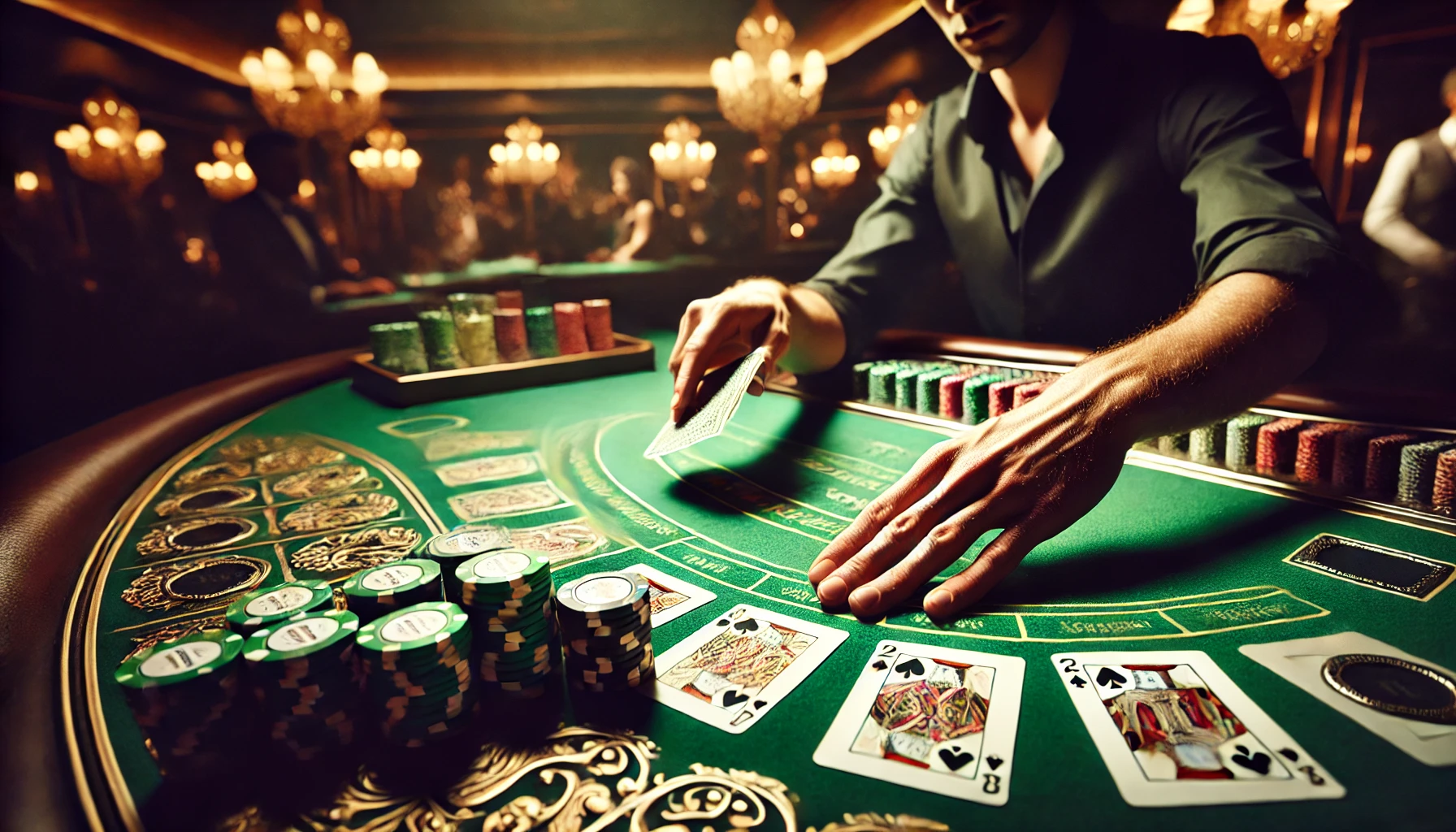Thoroughly shuffle the deck using riffle, overhand, and other techniques. Insert a plastic cut card about 1.5 decks from the bottom. Have players place their bets in the designated circles before you deal the cards. Deal one up card to each player, starting from the left, and one down card to yourself. Offer insurance if your up card is an Ace. Let players hit, stand, double down, split pairs, or surrender as they wish. Reveal your hole card and finish the hand, paying out winners and collecting losing bets. Continue reading to discover the full process in detail.
Shuffling and Cutting the Deck
Proper card shuffling and cutting are essential in blackjack, as they establish the random order of the deck and prevent any potential cheating or advantage play. Begin by thoroughly shuffling the cards using a combination of riffle shuffles, overhand shuffles, and other techniques to guarantee a well-mixed deck.
Once the cards are shuffled, have a player cut the deck by inserting a plastic cut card about 1.5 decks from the bottom. This cut card will mark where to separate the cards.
For larger groups, you can combine up to 6-8 decks to change the odds and make the game more challenging. However, avoid excessive card manipulations and keep the shuffle process efficient and smooth.
When the cards are cut, place the cut card in the middle of the deck, ready for the players to place their bets. Then, deal one card face-up to each player and the dealer, starting from the player’s left and moving clockwise around the blackjack table.
Placing Player Bets
After the cards have been shuffled and the deck cut, players must place their bets in the designated betting circles in front of them before the dealer begins dealing the cards. Players can’t place additional bets or adjust their bets once the dealer has started dealing the cards. The dealer, acting on behalf of the house, doesn’t need to place any bets.
In a home game, the dealing responsibility should rotate among the players after each hand. Players should only bet money they’re comfortable losing, or use chips or other score trackers to keep track of their winnings.
To place their bets, players can bet by placing the right amount of chips from the bank in the designated betting circles. This initial bet gives players the option to make additional plays, such as splitting or doubling down, depending on the cards dealt.
Dealing the First Cards
Once the cards have been shuffled and the deck cut, begin dealing the first cards. First, discard the first card (the burn card) without looking. Then, deal one up card to each player, starting with the player to the dealer’s left and moving from left to right.
Next, deal one down card to the dealer, followed by a second up card to each player and the dealer’s up card.
Before dealing the cards, verify all players have placed their bets:
- Offer insurance to players if the dealer’s up card is an Ace.
- Deal the cards from left to right, starting with the player to the dealer’s left.
- The player gets two cards, and the dealer gets two cards (one up and one down).
- The player and the dealer now have their first two cards to begin the game of Blackjack.
Handling Player Decisions
When it’s your turn, you’ve got several options. You can hit to draw another card, stand to keep your current total, double down to double your bet and receive one more card, split pairs to turn one hand into two, or surrender to fold and get back half your bet.
Mastering these key player decisions is vital for success at the blackjack table.
Hitting, Standing, Doubling
As a blackjack player, you’ll have several essential decisions to make during the game. Namely, you can choose to hit, stand, or double down.
If you hit, you’ll receive an additional card in an attempt to get closer to 21 without going over. However, you can no longer hit or double down after taking a hit.
If you stand, you’ll keep your current hand total and end your turn. This can be a smart choice if you’re already close to 21 or if you’re unsure about hitting.
Doubling down allows you to double your original bet, but you’ll only receive one additional card. This can be a risky move, but it also has the potential to increase your winnings greatly.
- Hitting can help you get closer to 21, but you can’t hit or double after.
- Standing keeps your current hand total and ends your turn.
- Doubling down doubles your bet but limits you to one more card.
- Doubling down is risky but can pay off big if done strategically.
Splitting Pairs, Surrendering
In addition to hitting, standing, and doubling down, players can often split pairs of cards with the same rank into two separate hands. The casino’s rules determine how many times you can re-split these pairs.
When you’re dealt a pair of aces, you’ll typically only receive one additional card per hand, and some casinos restrict the ability to re-split aces.
Another option is to surrender, where you forfeit half of your original bet and don’t receive any more cards for that round. Surrendering is usually only allowed before you take any other action on your hand, like hitting or doubling down. Surrendering can be a smart move when you’re dealt an unfavorable starting hand, allowing you to cut your losses. However, keep in mind that the option to surrender is subject to the casino’s rules.
Blackjack Payouts
Players receive a 3/2 payout if they’re dealt a blackjack, which is an ace and a ten-value card. This generous payout can boost a player’s bankroll enormously.
Additionally, players can choose to double down, allowing them to double their bet and receive exactly one more card. This can be a powerful strategy, but it’s important to use it judiciously.
If a player is dealt a pair of cards with the same rank, they can split the pair into two separate hands by placing an additional bet. This gives them a chance to potentially win big on both hands.
Furthermore, players can choose to surrender their hand, forfeiting half their bet if they’re unhappy with their initial two-card total. This can be a smart move in certain situations.
However, it’s indispensable to remember that busted hands (going over 21) automatically lose, and the dealer collects the player’s bet.
Revealing the Dealer’s Hand
After all players have completed their turns, it’s time to reveal the dealer’s hole card. Depending on the total in their hand and the house rules, the dealer may then hit or stand.
The dealer then compares their hand to the players’ hands, and players with a higher total than the dealer’s, up to 21, win their bets.
Reveal Dealer’s Hole Card
Once the players have completed their turns, the dealer will reveal their hidden card. This is a critical moment in the game, as the dealer’s hole card will determine the outcome of the hand.
The dealer will compare their hand total to the players’ hands, paying out or collecting bets accordingly.
If the dealer has a higher total than the players‘ hands, up to 21, the dealer collects the players’ bets.
If the player has a higher total than the dealer’s, up to 21, the player wins their bet at even money (1:1).
If the player and dealer have the same total, it’s a push and the player’s bet is returned.
Determine Dealer’s Total
Revealing the dealer’s hole card signals the start of the concluding stage of the blackjack hand. Depending on the house rules, the dealer must hit if their total is 16 or lower, and stand if their total is 17 or higher. This determines the dealer’s final hand total.
| Dealer’s Hand | Dealer’s Action |
|---|---|
| 17 or higher | Stand |
| 16 or lower | Hit |
If the dealer’s total exceeds 21, all remaining players win their bets. On the other hand, the dealer compares their final hand total to each player’s final hand total, paying out winning bets or collecting losing bets. In the case of a tie, the player’s bet is returned in a push.
The outcome of the hand hinges on the dealer’s final hand total. A bust will result in a win for the players, while a hand totaling 17 or higher will force the dealer to stand, allowing the players’ hands to be evaluated. Understanding the dealer’s actions based on their total is pivotal in managing the concluding stage of the blackjack game.
Compare Dealer’s Hand to Players’
The dealer’s hole card is now revealed, signaling the final stage of the blackjack hand. Depending on the dealer’s total and the house rules, they may choose to hit or stand.
The dealer then compares their hand to the players’ hands, and those with a total higher than the dealer’s, up to 21, win their bets.
If the dealer has a higher total, the player loses their bet. However, if it’s a tie, the player’s bet is returned in what’s called a push.
- The dealer’s hand is compared to each player’s hand.
- Players with a total higher than the dealer’s, up to 21, win their bets.
- If the dealer has a higher total, the player loses their bet.
- If it’s a tie, the player’s bet is returned in a push.
Determining the Winners
After the dealer has played out their hand, it’s time to compare each player’s hand to the dealer’s to determine the winners. The dealer will start with the player to their left and work their way around the table, one player at a time. They’ll keep track of each player’s hand total and compare it to their own.
Players with a hand total closer to 21 than the dealer’s hand total will be paid out at even money (1 to 1 odds). If a player has a blackjack (an ace and a 10-value card), they’ll be paid out at 3 to 2 odds. If the player and dealer have the same hand total, it’s a “push” and the player’s bet is returned.
Any hands that exceed 21 points are “busted” and the player loses their bet. The dealer will leave their cards on the table and move on to the next player. Once they’ve gone through every player, they’ll collect the losing bets and pay out the winners, putting the cards in the discard pile.
Completing the Round
Once the dealer has gone through each player’s hand, it’s time to complete the round. The dealer will now reveal their hole card, adding to the total in their hand. Depending on the house rules, the dealer may then choose to hit or stand based on this total.
The dealer then compares their hand to the players’ hands:
- If your total is higher than the dealer’s, up to 21, you win your bet.
- If the dealer’s total is higher, you lose your bet.
- If it’s a tie, your bet is returned in a push.
The dealer’s actions and the comparison of hands determine the outcome for each player. Stay alert as the round comes to a close, and be prepared to either collect your winnings or accept the loss of your bet. The game continues with the next round, where you’ll have another opportunity to test your blackjack skills.
Frequently Asked Questions
Does Dealer Hit on 16?
Yes, the dealer must hit on 16 according to standard blackjack rules. This mandatory hit on 16 is part of the dealer’s basic strategy and helps maintain the house edge, regardless of the player’s card counting strategies or soft/hard hand totals.
What Are the Basic Rules of Blackjack?
The basic rules of blackjack are to get a hand value closer to 21 than the dealer without going over. You can use basic blackjack strategy, double down rules, and manage your bankroll to beat the casino advantage in various blackjack variants.
What Happens if the Dealer and Player Get 21?
If you and the dealer both get 21 points, it’s a push. Your original bet is returned, and you can continue using your card counting strategies and betting progression systems to take advantage of the game’s variations and minimize the house advantage.
What Are the Rules for Splitting in Blackjack?
When you split pairs in blackjack, you can insure against blackjack, double down after splitting, and hit soft hands to avoid busting. Manage your bankroll, count cards, and calculate odds to choose the ideal splitting strategy.
Conclusion
Now that you’ve learned the basics of dealing blackjack, it’s time to put your skills into practice. Remember to stay focused, make strategic decisions, and have fun! The more you play, the more comfortable you’ll become with the process. So, grab your cards, shuffle the deck, and let’s get the game started! For those who prefer a seamless and anonymous gaming experience, NO-KYC crypto casino Wolfbet is the perfect place to test your blackjack skills with fast crypto transactions.




